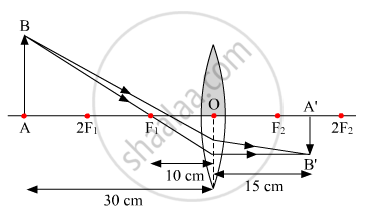Advertisements
Advertisements
प्रश्न
One half of a convex lens of focal length 10 cm is covered with a black paper. Can such a lens produce an image of a complete object placed at a distance of 30 cm from the lens? Draw a ray diagram to justify your answer. A 4 cm tall object is placed perpendicular to its principal axis of a convex lens of focal length 20 cm. The distance of the object from the lens is 15 cm. Find the nature, position and the size of the image.
उत्तर
An image is formed from a number of rays from the object getting refracted by the lens. The complete image will be formed even if one half of the lens is covered. However, the brightness of the image will be less.
Case I: When the upper half of the lens is covered
In this case, rays of light coming from the object get refracted by the lower half of the lens. These rays meet at the other side of the lens to form the image of the given object as shown in the following figure:

Case II: When the lower half of the lens is covered
A convex lens can produce the complete image of the object even though half of the lens is covered. This is because light coming from the object can be refracted from the other half of the lens. However, the intensity of light will be reduced.

Given:-
Height of the object = h = 4 cm
Focal length of the convex lens = f = 20 cm
Object distance = u = −15 cm
Using the lens formula, we get
`1/`
`therefore1/`
`therefore`
Hence, the image is formed 60 cm in front of the lens on the same side as the object. Because v is negative, we can say that the image is virtual.
From the magnification formula for the lens, we get
`m=(h')/h=`
`thereforeh'=(`
Hence, the size of the image is h′ = 16 cm.
Because the height of the image is positive and greater than the height of the object, the image is erect and magnified.
So, we can conclude that the image is virtual, erect and magnified.
APPEARS IN
संबंधित प्रश्न
How is a spherical mirror used to converge a beam of light at a point? Name the type of mirror used.
Answer the following question.
Write the modification in the curvature of the eye lens which enables us to see the nearby objects clearly?
Select the correct option:
A concave mirror is made by cutting a portion of a hollow glass sphere of radius 30 cm. The focal length of the concave mirror is:
Draw a ray diagram to show that a convex mirror has a wider field of view.
The minimum length of the mirror required to see the full image of the person is half ‘ of his height.
What is “aperture”?
